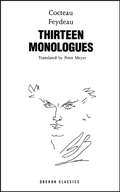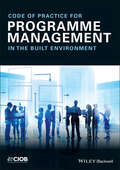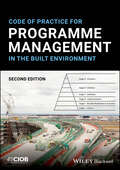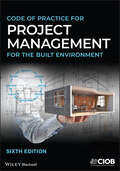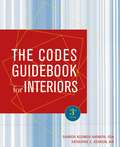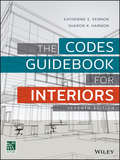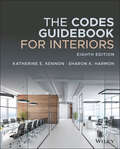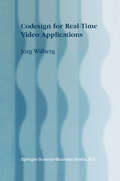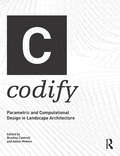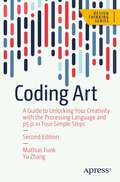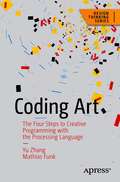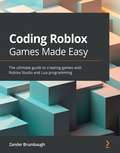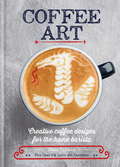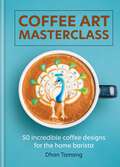- Table View
- List View
Cocos2d-x Game Development Blueprints
by Karan SequeiraIf you are a proficient Cocos2d game developer who wants to enhance his or her game development skill set using Cocos2d-x to build different types of games, this book is for you.
Cocteau & Feydeau: Thirteen Monologues
by Jean Cocteau Georges FeydeauContains original illustrations by Jean Cocteau and Andrzej Klimowski.Two of the seven monologues by Jean Cocteau (1889-1963) in this edition were written for Édith Piaf. The other five were written for Cocteau’s friend, the celebrated actor Jean Marais, to perform on radio. Although perhaps a minor part of Cocteau’s output of films, plays, poems and ballet scenarios, these exquisite miniatures remain a fascinating form of his dramatic expression.Georges Feydeau (1862-1921) is best known for his enduring farces, such as A Flea In Her Ear, yet he wrote over 20 monologues for actors to perform at charity concerts and in fashionable drawing rooms. The six included in this volume were written over a period of 16 years from 1882.Peter Meyer’s translations of eleven of these monologues were commissioned by the BBC and performed on radio by leading actors including Eileen Atkins, Jill Bennett, Richard Briers, Judi Dench, Alec McCowan and Timothy West. The Liar and I Lost Her have been newly translated for this volume.
Code of Practice for Programme Management: In the Built Environment
by CIOB (The Chartered Institute of Building)The CIOB Code of Practice Programme Management for Construction & Development is intended to complement the popular CIOB Code of Practice for Project Management for Construction and Development, providing practical coverage of general processes and procedures to be followed when managing a construction programme or portfolio of projects. It sets out the necessary requirements for effective and efficient programme management, but is not intended to be a manual of operating procedures for the manager of such programmes.
Code of Practice for Programme Management: In the Built Environment
by CIOB (The Chartered Institute of Building)The CIOB Code of Practice Programme Management for Construction & Development is intended to complement the popular CIOB Code of Practice for Project Management for Construction and Development, providing practical coverage of general processes and procedures to be followed when managing a construction programme or portfolio of projects. It sets out the necessary requirements for effective and efficient programme management, but is not intended to be a manual of operating procedures for the manager of such programmes.
Code of Practice for Programme Management in the Built Environment
by CIOB (The Chartered Institute of Building)CODE OF PRACTICE FOR PROGRAMME MANAGEMENT IN THE BUILT ENVIRONMENT Manage a construction programme from start to finish with this up-to-date guide The maturation and proliferation of project management principles has been one of the most important stories in recent business history. So widely has project management spread throughout the corporate world that it has now given way to a similar discipline, programme management, designed to align, coordinate and manage a number of related projects as a whole. In the construction industry particularly, programme management can deliver benefits that would not have been possible to realise had individual projects been managed independently. Produced by the Chartered Institute of Building (CIOB), the revised Code of Practice for Programme Management in the Built Environment provides a comprehensive overview of the tools required to deliver such benefits, and how they are applied in construction programmes. A natural complement to the CIOB’s popular Code of Practice for Project Management for the Built Environment, it is now fully updated to reflect new insights and best practices. Readers of the second edition of Code of Practice for Programme Management in the Built Environment will find: Theoretical and practical insights derived from research and experience Coverage of setting up programmes successfully so that teams feel confident to deliver the final outcome Guidelines for implementing programme management for the built environment Code of Practice for Programme Management in the Built Environment is ideal for programme management and project management professionals involved in this industry and in particular, contractors and client organisations, as well as for advanced undergraduate and postgraduate students in construction project management and other related disciplines. The Chartered Institute of Building is the world’s largest professional body for construction management and leadership. It has a Royal Charter to promote the science and practice of building and construction for the benefit of society. Members across the world work in the development, conservation, and improvement of the built environment.
Code of Practice for Programme Management in the Built Environment
by CIOB (The Chartered Institute of Building)CODE OF PRACTICE FOR PROGRAMME MANAGEMENT IN THE BUILT ENVIRONMENT Manage a construction programme from start to finish with this up-to-date guide The maturation and proliferation of project management principles has been one of the most important stories in recent business history. So widely has project management spread throughout the corporate world that it has now given way to a similar discipline, programme management, designed to align, coordinate and manage a number of related projects as a whole. In the construction industry particularly, programme management can deliver benefits that would not have been possible to realise had individual projects been managed independently. Produced by the Chartered Institute of Building (CIOB), the revised Code of Practice for Programme Management in the Built Environment provides a comprehensive overview of the tools required to deliver such benefits, and how they are applied in construction programmes. A natural complement to the CIOB’s popular Code of Practice for Project Management for the Built Environment, it is now fully updated to reflect new insights and best practices. Readers of the second edition of Code of Practice for Programme Management in the Built Environment will find: Theoretical and practical insights derived from research and experience Coverage of setting up programmes successfully so that teams feel confident to deliver the final outcome Guidelines for implementing programme management for the built environment Code of Practice for Programme Management in the Built Environment is ideal for programme management and project management professionals involved in this industry and in particular, contractors and client organisations, as well as for advanced undergraduate and postgraduate students in construction project management and other related disciplines. The Chartered Institute of Building is the world’s largest professional body for construction management and leadership. It has a Royal Charter to promote the science and practice of building and construction for the benefit of society. Members across the world work in the development, conservation, and improvement of the built environment.
Code of Practice for Project Management for the Built Environment
by CIOB (The Chartered Institute of Building)The latest edition of the gold standard in construction project management references In the newly revised sixth edition of Code of Practice for Project Management for Construction and Development, the Chartered Institute of Building delivers an up-to-date and comprehensive reference to the principles and practice of project management in construction and development. This latest edition covers the new technologies, internationalisation, changing legislation, and productivity and profitability challenges faced by contractors that are driving significant change in the industry. The book demonstrates the application of systematic documentation and quality control to complex construction projects and offers specimen forms, checklists, and documentation that link key principles to practical project management. It is worldwide in scope and widely recognised as the industry standard on the subject. With fresh discussions of quality assurance, global codes and standards, time management, joint ventures, contract compliance, supply chain integration, design digitisation, and much more, the Code of Practice for Project Management for Construction and Development also includes: A thorough introduction to project inception, feasibility analysis, strategy, and the pre-construction process Comprehensive explorations of the construction stage of projects, as well as testing and commissioning, and project completion, handover, and operation Practical discussions of post-completion review A complete glossary and index of essential terms in construction project management Perfect for project management professionals in construction contracting and client organisations, Code of Practice for Project Management for Construction and Development will also earn a place in the libraries of undergraduate and postgraduate students of project management and construction-related subjects.
Code of Practice for Project Management for the Built Environment
by CIOB (The Chartered Institute of Building)The latest edition of the gold standard in construction project management references In the newly revised sixth edition of Code of Practice for Project Management for Construction and Development, the Chartered Institute of Building delivers an up-to-date and comprehensive reference to the principles and practice of project management in construction and development. This latest edition covers the new technologies, internationalisation, changing legislation, and productivity and profitability challenges faced by contractors that are driving significant change in the industry. The book demonstrates the application of systematic documentation and quality control to complex construction projects and offers specimen forms, checklists, and documentation that link key principles to practical project management. It is worldwide in scope and widely recognised as the industry standard on the subject. With fresh discussions of quality assurance, global codes and standards, time management, joint ventures, contract compliance, supply chain integration, design digitisation, and much more, the Code of Practice for Project Management for Construction and Development also includes: A thorough introduction to project inception, feasibility analysis, strategy, and the pre-construction process Comprehensive explorations of the construction stage of projects, as well as testing and commissioning, and project completion, handover, and operation Practical discussions of post-completion review A complete glossary and index of essential terms in construction project management Perfect for project management professionals in construction contracting and client organisations, Code of Practice for Project Management for Construction and Development will also earn a place in the libraries of undergraduate and postgraduate students of project management and construction-related subjects.
The Codes Guidebook for Interiors
by Sharon K. Harmon Katherine E. KennonNow available in an updated and expanded third edition, The Codes Guidebook for Interiors incorporates the latest standards for interior projects. The book presents the International Building Code, Life Safety Code, NFPA 5000, ICC/ANSI accessibility standard, and many others in a clear, jargon-free style. In addition, you'll find a thorough referencce for the NCIDQ exam or the interior portion of the ARE. Whether you're an architect, interior designer, facilities manager, construction manager, or developer, The Codes Guidebook for Interiors, Third Edition is an indispensable tool of the trade. Order your copy today.
The Codes Guidebook for Interiors: Wiley E-text Folder And Interactive Resource Center Access Card
by Katherine E. Kennon Sharon K. HarmonInterior codes and standards reference of choice for designers and architects, updated and revised Completely revised and updated, the seventh edition of The Codes Guidebook to Interiors is the only book devoted exclusively to codes that are applicable to interior designers. The guide features jargon-free explanations of all the codes and standards that are relevant to designers and architects, including performance codes, building and finish standards, energy codes, and ADA standards. In addition, the dozens of examples and a greatly enhanced with a set of illustrations, including floor plans, that clearly show how codes apply to real-world project. Written by Katherine E. Kennon (a professional architect and facilities planner) and Sharon Koomen Harmon (a professional interior designer and educator) are experts on interior design and architecture codes. Updated coverage contains the most recent ICC codes, including the International Building Code and new material on the ICC International Green Construction Code, as well as the NFPA's most recent Life code. The authors address a wide-variety of building and project types (large and small) and they offer information on single family homes and historical and existing buildings. The seventh edition includes: Easy-to-navigate format geared toward the code process as a whole A step-by-step guide through the codes relevant at each stage in the design process The newest changes to the ADA Standards and ICC/ASI accessibility requirements A companion site that offers interactive checklists, flashcards, PowerPoint lecture slides, and an Instructor's Manual Having all applicable codes in a single resource saves hours of research time, and can dramatically reduce the potential for costly planning oversights. Whether renovation or new construction, small or large, codes apply to every project. The Codes Guidebook for Interiors provides designers with the comprehensive information they need to stay up-to-date.
The Codes Guidebook for Interiors
by Katherine E. Kennon Sharon K. HarmonInterior codes and standards reference of choice for designers and architects, updated and revised Completely revised and updated, the seventh edition of The Codes Guidebook to Interiors is the only book devoted exclusively to codes that are applicable to interior designers. The guide features jargon-free explanations of all the codes and standards that are relevant to designers and architects, including performance codes, building and finish standards, energy codes, and ADA standards. In addition, the dozens of examples and a greatly enhanced with a set of illustrations, including floor plans, that clearly show how codes apply to real-world project. Written by Katherine E. Kennon (a professional architect and facilities planner) and Sharon Koomen Harmon (a professional interior designer and educator) are experts on interior design and architecture codes. Updated coverage contains the most recent ICC codes, including the International Building Code and new material on the ICC International Green Construction Code, as well as the NFPA's most recent Life code. The authors address a wide-variety of building and project types (large and small) and they offer information on single family homes and historical and existing buildings. The seventh edition includes: Easy-to-navigate format geared toward the code process as a whole A step-by-step guide through the codes relevant at each stage in the design process The newest changes to the ADA Standards and ICC/ASI accessibility requirements A companion site that offers interactive checklists, flashcards, PowerPoint lecture slides, and an Instructor's Manual Having all applicable codes in a single resource saves hours of research time, and can dramatically reduce the potential for costly planning oversights. Whether renovation or new construction, small or large, codes apply to every project. The Codes Guidebook for Interiors provides designers with the comprehensive information they need to stay up-to-date.
The Codes Guidebook for Interiors
by Katherine E. Kennon Sharon K. HarmonTHE INTERIOR CODES AND STANDARDS REFERENCE OF CHOICE FOR DESIGNERS AND ARCHITECTS—UPDATED FOR THE 2018 AND 2021 CODES If you are involved with the design or management of buildings and spaces, it is important to remain up-to-date on the ever-evolving codes and standards that keep communities safe. With over 80,000 copies sold, The Codes Guidebook for Interiors continues to provide comprehensive explanations of the major codes and standards applicable to commercial and residential interior projects. The easily navigable format gives clear perspective to how these often confusing concepts and requirements are integrated into real world practice, helping designers incorporate the relevant standards into their projects. Updated with the most recent changes and insights to the codes and standards of the ICC, NFPA, ANSI, ADA, and other standards, the Eighth Edition provides unparalleled and integrated guidance on building safety, accessibility, sustainability, energy efficiency, and more. Updates to the Eighth Edition include: Explanations of code requirements, highlighting the latest changes in the 2018 and 2021 ICC codes, including the International Building Code and the NFPA’s Life Safety Code Clarifications to how and when the ADA, ABA and the ICC/ANSI accessibility requirements will apply to a project Introduction to the codes and standards that address sustainability in typical projects In-depth examinations of fire and smoke resistant assemblies, fire protection systems, and plumbing and mechanical requirements A companion website with printable study flashcards, instructor’s manual, and PowerPoint slides for use in academic settings Digital and printable code checklists that can guide code research for professional projects and use in a design studio Current, practical, and relevant to nearly any interior or architectural project, The Codes Guidebook for Interiors provides invaluable insight and reference for both student and professional interior designers and architects.
The Codes Guidebook for Interiors
by Katherine E. Kennon Sharon K. HarmonTHE INTERIOR CODES AND STANDARDS REFERENCE OF CHOICE FOR DESIGNERS AND ARCHITECTS—UPDATED FOR THE 2018 AND 2021 CODES If you are involved with the design or management of buildings and spaces, it is important to remain up-to-date on the ever-evolving codes and standards that keep communities safe. With over 80,000 copies sold, The Codes Guidebook for Interiors continues to provide comprehensive explanations of the major codes and standards applicable to commercial and residential interior projects. The easily navigable format gives clear perspective to how these often confusing concepts and requirements are integrated into real world practice, helping designers incorporate the relevant standards into their projects. Updated with the most recent changes and insights to the codes and standards of the ICC, NFPA, ANSI, ADA, and other standards, the Eighth Edition provides unparalleled and integrated guidance on building safety, accessibility, sustainability, energy efficiency, and more. Updates to the Eighth Edition include: Explanations of code requirements, highlighting the latest changes in the 2018 and 2021 ICC codes, including the International Building Code and the NFPA’s Life Safety Code Clarifications to how and when the ADA, ABA and the ICC/ANSI accessibility requirements will apply to a project Introduction to the codes and standards that address sustainability in typical projects In-depth examinations of fire and smoke resistant assemblies, fire protection systems, and plumbing and mechanical requirements A companion website with printable study flashcards, instructor’s manual, and PowerPoint slides for use in academic settings Digital and printable code checklists that can guide code research for professional projects and use in a design studio Current, practical, and relevant to nearly any interior or architectural project, The Codes Guidebook for Interiors provides invaluable insight and reference for both student and professional interior designers and architects.
Codesign for Real-Time Video Applications
by Jörg WilbergCodesign for Real-Time Video Applications describes a modern design approach for embedded systems. It combines the design of hardware, software, and algorithms. Traditionally, these design domains are treated separately to reduce the design complexity. Advanced design tools support a codesign of the different domains which opens an opportunity for exploiting synergetic effects. The design approach is illustrated by the design of a video compression system. It is integrated into the video card of a PC. A VLIW processor architecture is used as the basis of the compression system and popular video compression algorithms (MPEG, JPEG, H.261) are analyzed. A complete top-down design flow is presented and the design tools for each of the design steps are explained. The tools are integrated into an HTML-based design framework. The resulting design data can be directly integrated into the WWW. This is a crucial aspect for supporting distributed design groups. The design data can be directly documented an cross referencing in an almost arbitrary way is supported. This provides a platform for information sharing among the different design domains. Codesign for Real-Time Video Applications focuses on the multi-disciplinary aspects of embedded system design. It combines design automation and advanced processor design with an important application domain. A quantitative design approach is emphasized which focuses the design time on the most crucial components. Thus enabling a fast and cost efficient design methodology. This book will be of interest to researchers, designers and managers working in embedded system design.
Codify: Parametric and Computational Design in Landscape Architecture
by Bradley Cantrell Adam MekiesCodify: Parametric and Computational Design in Landscape Architecture provides a series of essays that explore what it means to use, modify and create computational tools in a contemporary design environment. Landscape architecture has a long history of innovation in the areas of computation and media, particularly in how the discipline represents, analyses, and constructs complex systems. This curated volume spans academic and professional projects to form a snapshot of digital practices that aim to show how computation is a tool that goes beyond methods of representation and media. The book is organized in four sections; syntax, perception, employ, and prospective. The essays are written by leading academics and professionals and the sections examine the role of computational tools in landscape architecture through case studies, historical accounts, theoretical arguments, and nascent propositions.
Codify: Parametric and Computational Design in Landscape Architecture
by Bradley Cantrell Adam MekiesCodify: Parametric and Computational Design in Landscape Architecture provides a series of essays that explore what it means to use, modify and create computational tools in a contemporary design environment. Landscape architecture has a long history of innovation in the areas of computation and media, particularly in how the discipline represents, analyses, and constructs complex systems. This curated volume spans academic and professional projects to form a snapshot of digital practices that aim to show how computation is a tool that goes beyond methods of representation and media. The book is organized in four sections; syntax, perception, employ, and prospective. The essays are written by leading academics and professionals and the sections examine the role of computational tools in landscape architecture through case studies, historical accounts, theoretical arguments, and nascent propositions.
Coding Art: A Guide to Unlocking Your Creativity with the Processing Language and p5.js in Four Simple Steps (Design Thinking)
by Mathias Funk Yu ZhangFinally, a book on creative programming, written directly for artists and designers! This second edition offers expanded and updated content incorporating the latest advancements and trends in the field of creative programming, also for creatives who want to work directly with P5.js and online. It delves deeper into the intricacies of computational art. It includes fresh case studies that explore real-world applications of coding art, inspiring readers to think beyond traditional boundaries.Rather than following a computer science curriculum, this book is aimed at creatives who are working in the intersection of design, art, and education. Following a real-world use case of computation art, you'll see how it relates back to the four key pillars, and addresses potential pitfalls and challenges in the creative process. All code examples are presented in a fully integrated Processing example library, making it easy for readers to get started. This unique and finely balanced approach between skill acquisition and development makes Coding Art, Second Edition the ideal reference book for both creative programming and the creative process for professors and students alike.What You’ll LearnReview ideas and approaches from creative programming to different professional domainsWork with computational tools like the Processing languageUnderstand the skills needed to move from static elements to animation to interactionUse interactivity as input to bring creative concepts closer to refinement and depthSimplify and extend the design of aesthetics, rhythms, and smoothness with data structuresLeverage the diversity of art code on other platforms like the web or mobile applicationsUnderstand the end-to-end process of computation art through real world use casesStudy best practices, common pitfalls, and challenges of the creative processWho This Book Is ForThose looking to see what computation and data can do for their creative expression; learners who want to integrate computation and data into their practices in different perspectives; creative technologists, educators, digital artists and those who already know how to program, seeking creativity and inspiration in the context of computation and data.
Coding Art: The Four Steps to Creative Programming with the Processing Language (Design Thinking)
by Yu Zhang Mathias FunkFinally, a book on creative programming, written directly for artists and designers! Rather than following a computer science curriculum, this book is aimed at creatives who are working in the intersection of design, art, and education. In this book you'll learn to apply computation into the creative process by following a four-step process, and through this, land in the cross section of coding and art, with a focus on practical examples and relevant work structures. You'll follow a real-world use case of computation art and see how it relates back to the four key pillars, and addresses potential pitfalls and challenges in the creative process. All code examples are presented in a fully integrated Processing example library, making it easy for readers to get started.This unique and finely balanced approach between skill acquisition and the creative process and development makes Coding Art a functional reference book for both creative programming and the creative process for professors and students alike.What You’ll LearnReview ideas and approaches from creative programming to different professional domainsWork with computational tools like the Processing languageUnderstand the skills needed to move from static elements to animation to interactionUse interactivity as input to bring creative concepts closer to refinement and depthSimplify and extend the design of aesthetics, rhythms, and smoothness with data structuresLeverage the diversity of art code on other platforms like the web or mobile applicationsUnderstand the end-to-end process of computation art through real world use casesStudy best practices, common pitfalls, and challenges of the creative processWho This Book Is ForThose looking to see what computation and data can do for their creative expression; learners who want to integrate computation and data into their practices in different perspectives; and those who already know how to program, seeking creativity and inspiration in the context of computation and data.
Coding Roblox Games Made Easy: The ultimate guide to creating games with Roblox Studio and Lua programming
by Zander BrumbaughGet up and running with Roblox development with the help of expert guidance for working with Roblox components and Lua programmingKey FeaturesDiscover solutions to common problems faced while creating games on RobloxExplore tips, tricks, and best practices and learn advanced Roblox coding techniques to create gamesUnderstand how to program in the Roblox Lua language, add engaging effects, add a variety of functionalities, and much moreBook DescriptionRoblox is a global virtual platform like no other for both playing and creating games. With well over 150 million monthly active users, Roblox hosts all genres of games that can be played by other members of the community using the Lua programming language. Not only can you create games for free, but you can also earn considerable sums of money if from the success of your games, and become part of the vast and supportive developer circle that provides excellent opportunities for networking in a tight-knit community. With this practical book, you'll get hands-on experience working on the Roblox platform. You'll start with an overview of Roblox development and then understand how to use Roblox Studio. As you progress, you'll gradually learn everything you need from how to program in Roblox Lua to creating Obby and Battle Royale games. Finally, you'll delve into the logistics of game production, focusing on optimizing the performance of your game by implementing impressive mechanics, monetization, and marketing practices. By the end of this Roblox book, you'll be able to lead or work with a team to bring your gaming world to life, and extend that experience to players around the world.What you will learnGet started with Roblox development and explore aspects such as choosing a developer typeUnderstand how to use Roblox Studio and other free resourcesCreate your first game with the Roblox Lua programming languageBecome well-versed with the three Ms - Mechanics, Monetization, and MarketingDevelop real-world games such as Battle Royale and ObbyDiscover expert tips for collaborating effectively and managing project workloadsWho this book is forThis Roblox guide is for anyone interested in learning how to develop games on the Roblox platform. If you're already familiar with Roblox and looking for tips, tricks, and Roblox and Lua best practices for efficient development, you'll find this book helpful.
Coding, Shaping, Making: Experiments in Form and Form-Making
by Haresh LalvaniCoding, Shaping, Making combines inspiration from architecture, mathematics, biology, chemistry, physics and computation to look towards the future of architecture, design and art. It presents ongoing experiments in the search for fundamental principles of form and form-making in nature so that we can better inform our own built environment. In the coming decades, matter will become encoded with shape information so that it shapes itself, as happens in biology. Physical objects, shaped by forces as well, will begin to design themselves based on information encoded in matter they are made of. This knowledge will be scaled and trickled up to architecture. Consequently, architecture will begin to design itself and the role of the architect will need redefining. This heavily illustrated book highlights Haresh Lalvani’s efforts towards this speculative future through experiments in form and form-making, including his work in developing a new approach to shape‐coding, exploring higher‐dimensional geometry for designing physical structures and organizing form in higher-dimensional diagrams. Taking an in-depth look at Lalvani’s pioneering experiments of mass customization in industrial products in architecture, combined with his idea of a form continuum, this book argues for the need for integration of coding, shaping and making in future technologies into one seamless process. Drawing together decades of research, this book will be a thought-provoking read for architecture professionals and students, especially those interested in the future of the discipline as it relates to mathematics, science, technology and art. It will also interest those in the latter fields for its broader implications.
Coding, Shaping, Making: Experiments in Form and Form-Making
by Haresh LalvaniCoding, Shaping, Making combines inspiration from architecture, mathematics, biology, chemistry, physics and computation to look towards the future of architecture, design and art. It presents ongoing experiments in the search for fundamental principles of form and form-making in nature so that we can better inform our own built environment. In the coming decades, matter will become encoded with shape information so that it shapes itself, as happens in biology. Physical objects, shaped by forces as well, will begin to design themselves based on information encoded in matter they are made of. This knowledge will be scaled and trickled up to architecture. Consequently, architecture will begin to design itself and the role of the architect will need redefining. This heavily illustrated book highlights Haresh Lalvani’s efforts towards this speculative future through experiments in form and form-making, including his work in developing a new approach to shape‐coding, exploring higher‐dimensional geometry for designing physical structures and organizing form in higher-dimensional diagrams. Taking an in-depth look at Lalvani’s pioneering experiments of mass customization in industrial products in architecture, combined with his idea of a form continuum, this book argues for the need for integration of coding, shaping and making in future technologies into one seamless process. Drawing together decades of research, this book will be a thought-provoking read for architecture professionals and students, especially those interested in the future of the discipline as it relates to mathematics, science, technology and art. It will also interest those in the latter fields for its broader implications.
Coen Brothers - Virgin Film (Virgin Film Ser.)
by Eddie RobsonJoel and Ethan Coen make up one of the most original and unconventional movie-making partnerships to come out of America at the end of the 20th century. From their debut tour de force Blood Simple to the hugely acclaimed The Man Who Wasn't There, the brothers' films have attracted critical kudos and commercial success in equal measure due to their irreverent, individual and technically virtuoso nature. Each of their films defies categorisation, yet you're never in any doubt you're watching a Coen brothers movie. This exploration of the movie career of Hollywood's best-loved outsiders charts their rise from cult favourites to box-office contenders, whilst combining indispensable reference material and critical analysis of their films.
Coffee Art: Creative Coffee Designs for the Home Barista
by Dhan TamangOver 128 pages of 60 stunning designs from Britain's champion latte artist. From free pouring to etching, stencilling and more complicated designs for the black belt barista, you'll have fun emulating innovative designs such as The Swan, The Unicorn, and frothy 3-D babyccino animals. The book even includes 9 stencil patterns for you to trace and try.Starting with basic skills and patterns, readers will learn how to create the crema (the froth that acts as a canvas in the coffee cup) and how to produce the hearts, rosettas and tulips that will be used as the basis to form more complicated artworks. Dhan Tamang is a world-renowned latte artist particularly known for his use of colour, and now you too can create impressive multicoloured designs following Dhan's step-by-step instructions. By the end of this book you will be able to create fabulous designs to delight family members and dinner party guests alike.
Coffee Art Masterclass: 50 incredible coffee designs for the home barista
by Dhan TamangTake your coffee art to the next level with 50 spectacular-yet-simple latte art designs to impress family and friends. From the comfort of your own kitchen you can recreate great paintings, pour and etch stunning natural wonders, iconic buildings and fantastical creatures. No special equipment is needed and once you've mastered the basics a world of incredible coffee art awaits you.Coffee Art Masterclass includes next-level latte designs that everyone can achieve.
Cognition and the Built Environment
by Ole MöystadCognition and the Built Environment argues that interacting with our built environment, as users and as architects, is a cognitive process. It claims that architecture, in its form and meaning, is a basic, embodied level of human cognition. The assumption is that we and our built environment together form an intelligent system, a cognitive feedback loop between us and the world of which we are part. With this as a vantage point, the book discusses the meaning and intelligence of concrete architectural environments as well as the agency of the architect, of his client and of the user. The inquiry oscillates between abstract thought, topological models and cognitive semiotics, between pragmatist philosophy and the professional practice of planning cities, developing projects and using objects. Architecture serves more complex purposes than our caves, paths and landmarks did. Written for students and academics of urban design, urban planning and architectural theory, Cognition and the Built Environment argues that human cognition feeds on the interaction between thought, agency and built environment, and that architecture is the spatial form of this interaction.

